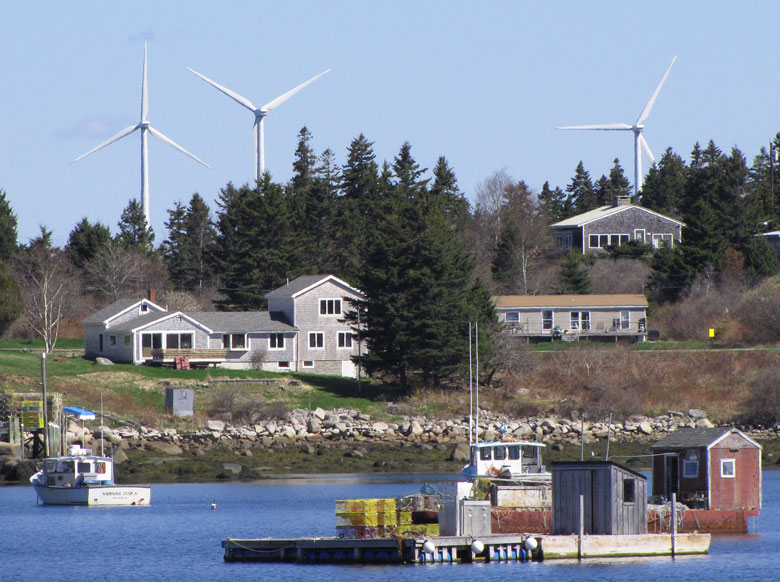Fifteen years after its spinning blades began generating electricity, the Fox Islands Wind project succeeded in saving islanders money. In fact, customers on the islands it serves—Vinalhaven and North Haven—have paid less for electricity than their mainland counterparts in the first decade of operation.
But challenges loom, including the aging of the turbines, which will force a vote in the near future on either repowering or decommissioning wind energy generation.
The 1.5-megawatt-producing turbines have achieved laudable climate goals, the staff of the nonprofit Fox Islands Electric Cooperative report, offsetting the release of 36,600 tons of carbon dioxide into the atmosphere.
The turbines are owned by the cooperative, its subsidiary Fox Islands Wind, and the resident customers of Vinalhaven and North Haven. Fox Island Electric now owns the property where the wind turbines stand and leases the land to Fox Islands Wind.
The numbers show that for ten of the first 11 years of wind turbine operation, Fox Island electricity cost less than the ISO New England market rate.
The power company hired Amy Turner, an attorney and previous general counsel for a large electric cooperative in Colorado, as CEO in 2020. In the face of change, the cooperative is seeking input and maintaining transparency, she said.
“The directors of Fox Islands Electric and Fox Islands Wind have been hosting community meetings to discuss the challenges and options of creating, operating, and maintaining a modern electric grid that meets our community’s vision,” Turner said. Past meetings can be viewed on the FoxIslandsWind.com website, where future meetings are also announced.
The meetings are also preparation for a decision on the future of the wind turbines. At close to 15-years-old, they are nearing their 20-year life span. Turner is focusing on providing residents with the full picture of what electrity has cost in the past 15 years.

She is also working on realistic projections of what future electricity will cost if the turbines are repowered and coupled with battery storage and other renewable energy such as community solar.
Hannah Pingree, director of the Governor’s Office of Policy Innovation and the Future, co-chair of the Maine Climate Council, and a North Haven resident, took part in the dedication ceremony for the turbines in 2009.
“Fox Islands Wind came about as our island communities faced an urgent crisis of how to replace a failing, expensive power cable and realize the benefits of locally generated clean power,” she said. “Its existence speaks to the ability of small communities to accomplish big, clean energy projects for the benefit of local citizens.”
Pingree supports the proposed “upgrades and additive clean energy investments,” she said, “such as battery storage, to benefit island ratepayers and strengthen the resilience of our energy grid against intense storms and other climate effects.”
Board member Charles Gadzik said that before Turner’s arrival as CEO, the local power company had not provided enough information about its wind power over the years, leaving residents questioning whether the cost of the turbines was worth it.
Both Turner and Gadzik agree the cost of electricity is the main concern for many.
Turner, who explained the history of Fox Islands electricity costs at a December community meeting, has dug into all the data.
The success that comes out of the historical data shows that the more power the island produces and then uses to meet the islands’ needs, “the better off we’re going to be from the standpoints of reliability, affordability, and environmental responsibility,” Turner said.
The numbers show that for ten of the first 11 years of wind turbine operation, Fox Island electricity cost less than the ISO New England market rate.
Initially some of the increase over 6 cents per KWh was due to actions initiated by five residents living near the turbines who objected to sound levels. The actions resulted in environmental regulations to curtail noise by powering down the turbines overnight between the hours of 7 p.m. to 7 a.m. and replacing the original blades with a quieter version.
In 2020, a failed gear box put one of the turbines out of operation and the islands lost 30 percent of their power generation. Insurance covered much of the cost of the repair, but over the next few years the premium increased from around $50,000 to $270,00 annually, adding to overall electricity costs, according to Turner.
The cost of electricity has also increased due to buying peak rate power from the ISO New England power market to meet peak electricity needs on the islands. Though the turbines produce more electricity over the course of the year than the two islands use, production does not track with demand, and so a submarine cable drawing from the New England grid remains in use.
Turner explains that initially residents were given cost projections for the 20-year life of the turbines that overestimated how much electricity the turbines would produce.
Due to the intermittent nature of wind, turbines produce more power during high winds, and less during low winds.
When the turbines make more electricity than needed by customers, the excess electricity is sold to the New England market. When less electricity is produced than needed, power is purchased at market rate. The market rate fluctuates day and night, depending on demand.
On the islands, winds quiet down somewhere between the hours of 5 p.m. and 9 p.m., every day, year-round. This lull in the wind coincides with the time electricity demand is highest on the island and throughout New England.
During the lull, Fox Islands purchases electricity at peak demand rate. Excess electricity is often sold for lower rates at times of lower demand.
Transmission to and from the islands also adds costs. Turner points out that what residents may see as 10 cents per KWh for electricity supply on a CMP bill, would cost 14 cents per KWh to purchase on the island due to a transmission cost.
Another cause of revenue loss is transmission across the cable under Penobscot Bay to the mainland. While the cable is in good condition, a percentage of power is lost during transmission. This increases the cost when Fox Islands buys power and decreases revenue for power sold, Turner explained.
Electricity cost data does not include the on-island distribution costs, which Turner said are part of the bill, regardless of where the energy comes from. She praises Fox Islands’ four-member crew and others who work together to get the power back on during outages caused by storms and fallen trees. The local crew also does preventative maintenance and will always resolve outages faster than a mainland company, which prioritizes population centers, she said.
In keeping with lessons learned, future plans to repower the turbines aim to maximize economic benefits and reduce revenue losses by storing excess electricity produced by the wind turbines and using it on the islands.
Repowering would require replacing the turbine gear box and blades, and possibly reusing the towers, she explained. The cost is currently estimated at about half of the original investment, as the site for the turbines and other important infrastructure is in place.
New turbines would be insulated, and run quieter, and at 1.9 MW can produce more power.
Turner is investigating the costs and benefits of battery storage to keep the energy produced for use on island, in place of selling power to and buying from the New England grid.
Community solar paired with battery storage is also being explored in order to meet peak demand during the summers.





